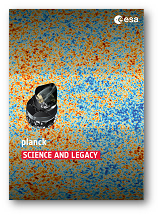ESA Science & Technology - Publication Archive
Publication archive
Publication archive
This brochure summarises the Planck mission and gives a glimpse of its main achievements.
Planck set out to map the very faint anisotropies in the Cosmic Microwave Background to an angular resolution and sensitivity that would exhaust all the cosmological information that can be extracted from them. In addition Planck has mapped the much fainter polarised fraction of these same anisotropies. The resulting maps of the sky contain traces from the very earliest times, revealing the recipe that embodies our most precise understanding of the structure, composition, and evolution of the Universe that we inhabit.
Contents:
- Foreword
- Making sense of the Universe
- The early Universe
- The Planck mission
- An almost perfect Universe
- Planck's view of the Cosmic Microwave Background
- The big and the small
- Structure formation and gravitational lensing
- The first stars
- Mapping foreground emission from the Milky Way
- A lasting legacy
This paper describes the identification, modelling, and removal of previously unexplained systematic effects in the polarization data of the Planck High Frequency Instrument (HFI) on large angular scales, including new mapmaking and calibration procedures, new and more complete end-to-end simulations, and a set of robust internal consistency checks on the resulting maps. These maps, at 100, 143, 217, and 353 GHz, are early versions of those that will be released in final form later in 2016. The improvements allow us to determine the cosmic reionization optical depth τ using, for the first time, the low-multipole EE data from HFI, reducing significantly the central value and uncertainty, and hence the upper limit. Two different likelihood procedures are used to constrain τ from two estimators of the CMB E- and B-mode angular power spectra at 100 and 143 GHz, after debiasing the spectra from a small remaining systematic contamination. These all give fully consistent results. A further consistency test is performed using cross-correlations derived from the Low Frequency Instrument maps of the Planck 2015 data release and the new HFI data. For this purpose, end-to-end analyses of systematic effects from the two instruments are used to demonstrate the near independence of their dominant systematic error residuals. The tightest result comes from the HFI-based τ posterior distribution using the maximum likelihood power spectrum estimator from EE data only, giving a value 0.055 ± 0.009. In a companion paper these results are discussed in the context of the best-fit Planck ΛCDM cosmological model and recent models of reionization.
We investigate constraints on cosmic reionization extracted from the Planck cosmic microwave background (CMB) data. We combine the Planck CMB anisotropy data in temperature with the low-multipole polarization data to fit ΛCDM models with various parameterizations of the reionization history. We obtain a Thomson optical depth τ = 0.058 ± 0.012 for the commonly adopted instantaneous reionization model. This confirms, with data solely from CMB anisotropies, the low value suggested by combining Planck 2015 results with other data sets, and also reduces the uncertainties. We reconstruct the history of the ionization fraction using either a symmetric or an asymmetric model for the transition between the neutral and ionized phases. To determine better constraints on the duration of the reionization process, we also make use of measurements of the amplitude of the kinetic Sunyaev-Zeldovich (kSZ) effect using additional information from the high-resolution Atacama Cosmology Telescope and South Pole Telescope experiments. The average redshift at which reionization occurs is found to lie between z = 7.8 and 8.8, depending on the model of reionization adopted. Using kSZ constraints and a redshift-symmetric reionization model, we find an upper limit to the width of the reionization period of ∆z < 2.8. In all cases, we find that the Universe is ionized at less than the 10 % level at redshifts above z ~ 10. This suggests that an early onset of reionization is strongly disfavoured by the Planck data. We show that this result also reduces the tension between CMB-based analyses and constraints from other astrophysical sources.
--- Remainder of abstract truncated due to character limitations ---
--- Remainder of abstract truncated due to character limitations ---
--- Remainder of abstract truncated due to character limitations ---
--- Remainder of abstract truncated due to character limitations ---
--- Remainder of abstract truncated due to character limitations ---
[Remainder of abstract truncated due to character limitations]
--- Remainder of abstract truncated due to character limitations ---
--- Remainder of abstract truncated due to character limitations ---
--- Remainder of abstract truncated due to character limitations ---

